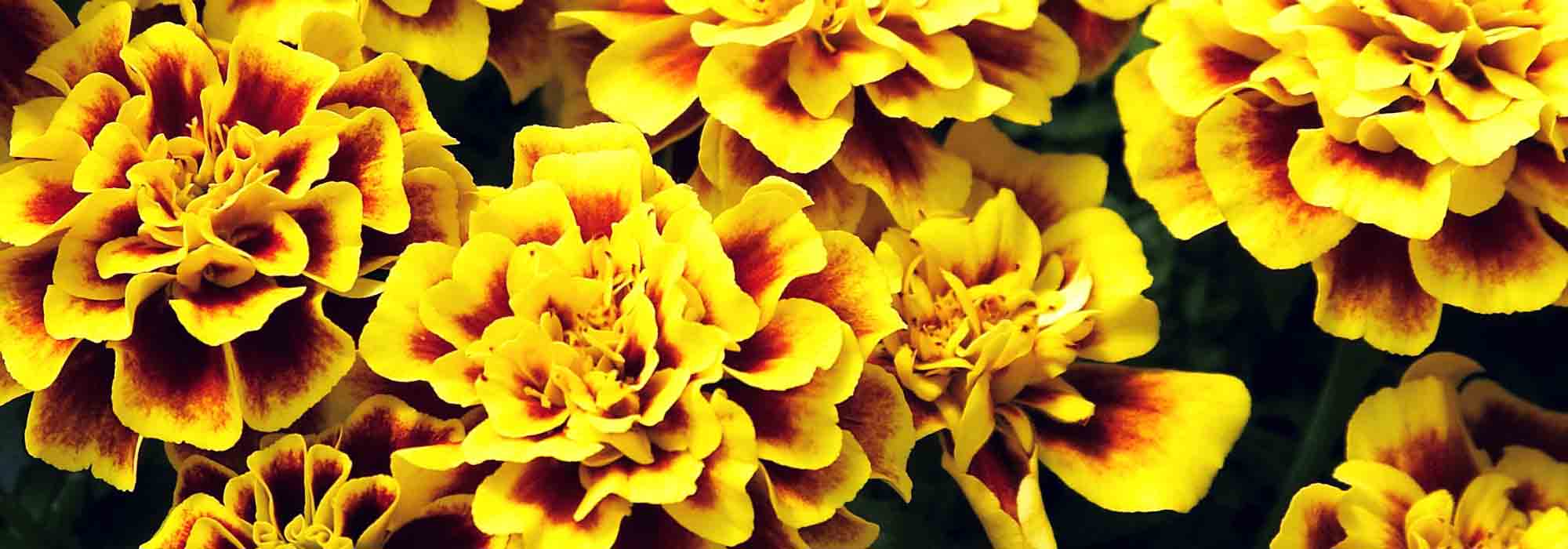
French marigold, Tagetes : sowing, planting, care
Contents
French marigold in a nutshell
- French marigold is the star annual plant in summer borders and around the vegetable patch
- It blooms from spring to autumn in warm, bright yellow and orange shades
- With its repellent scent with notes of citrus trees, it is also a useful asset in the home vegetable garden for controlling nematodes and aphids
- Sun-loving, it is foolproof and thrives in any well-drained soil
- In the garden, plant it in borders, rockeries, or on the terrace or balcony, in window boxes or containers
A word from our expert
Hard to get more cheerful and colourful! The French marigold or Tagetes lights up the garden like no other with its warm, vibrant colours! French marigold is a frost-tender perennial that does not survive winter and is grown as an annual in our gardens.
Sometimes overlooked because of its distinctive scent, Tagetes offers a simple, welcoming and above all very long flowering, which starts in May and continues regularly until first frosts in small single or double rusty, orange or golden-yellow heads.
Beyond its sunny beauty, French marigold has many assets: its flower is edible and it is renowned for its repellent effect in vegetable garden; it traditionally accompanies tomatoes, as its roots inhibit spread of nematodes while its peculiarly scented leaves repel aphids!
No flower is easier to grow! Foolproof, very floriferous, it is ideal annual flower for beginners! Its rapid growth and abundant flowering make it indispensable for quickly forming colourful, compact and ramified clumps in beds, borders, rockeries as well as pots and planters.
Discover our French marigolds or Tagetes in bucket or as seeds to compose colourful scenes in garden or on a sunlit terrace; they will prove themselves in all gardens, from simplest to most exuberant.
How to grow French marigolds? How to succeed with sowing French marigolds in open ground? What good companion plants for French marigolds in vegetable garden? Here are all our tips.
And fall for our unique collection of annual flowers!
Description and botany
Botanical data
- Latin name Tagetes
- Family Asteraceae
- Common name French marigold, Tagetes, African marigold
- Flowering May to autumn
- Height 0.30 to 1 m
- Exposure Sun
- Soil type any, well-drained
- Hardiness frost-tender
The Tagete, also called French marigold, is an herbaceous plant of the family Asteraceae, native to dry, warm valleys and slopes of Latin America and not India as one might think.
It is a perennial but frost-tender plant that is grown as an annual in our climates because of its sensitivity to cold. The genus includes about fifty species, among them the well-known Tagetes patula or French marigold, Tagetes erecta, African marigold and Tagetes tenuifolia (signata), the miniature French marigold. There is also the rose marigold resulting from a cross between the two previous species, which has even larger flowers and more vigorous growth.
There is also Tagetes lemonii, a Tagetes also called “shrubby marigold”.
For convenience, they are grouped under the common name “Tagetes”.
There are many dwarf varieties and hybrids, with simple or double flowers, including ‘Starfire’, ‘Crackerjack’ and the ‘Bonanza’ and ‘Boy’ series.
Tagetes grow very quickly but have a short lifespan; they self-seed easily in the garden. In a few months they form a bushy, branched, erect clump whose height ranges from 20 cm for dwarf varieties up to nearly 1 m for the tallest Tagetes, with a spread of about 40 cm.
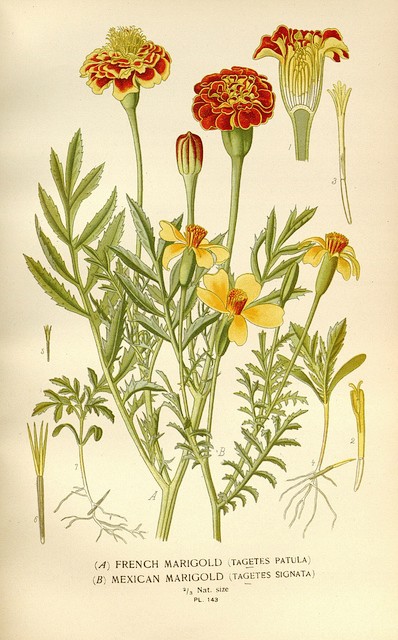
Tagetes patula – botanical illustration
Roots of French marigold release a substance that helps control fungal diseases and certain pests, notably nematodes, microscopic worms, as well as whiteflies (aleurodes) that attack roots of some vegetables.
This vigorous cushion with a neat habit and generally fairly low stature is covered with beautiful deciduous, deeply divided foliage evoking lightness of some ferns. The small opposite, pinnate leaves divided into linear to lanceolate leaflets with dentate margins bear conspicuous vesicles and have an almost feathery appearance. They measure 4 to 15 cm long and are fir green.
Foliage of Tagetes is also distinguished by its characteristic scent of citrus trees and pepper, more or less pleasant, which acts as a natural repellent against certain garden pests such as aphids.
Above this dark, aromatic and elegant foliage, particularly abundant, sunlit flowering appears. Numerous stems branched from the base bear at their tips large solitary heads or false cymes, which flower continuously from May–June until first frosts.
Flower structure varies according to species and cultivars and their forms have given rise to several types of Tagetes: “scabious-flowered” or “anemone-flowered”. Tagetes patula, the French marigold, has simple or double inflorescences with frilled or tubular petals, 2 to 5 cm in diameter. Tagetes erecta, the African marigold, is recognised by its larger, dense pompom-like double flowers, 5 to 12 cm wide. Tagetes tenuifolia (signata) is covered with tiny simple flowers.
Whether arranged in single or double rows, the ligules display very bright, warm hues, sometimes bordering on garish, ranging from bright orange to lemon yellow and deepest mahogany red. These radiant colours are sometimes bicoloured or striped, enlivened by a contrasting centre, bearing small darker central macules or margined with golden yellow.
Tireless, these melliferous, slightly scented flowers attract bees, butterflies and other pollinators from summer to autumn.
Once faded, they give way to brown fruits that self-seed easily.
French marigold flowers are pretty in bright summer bouquets. They are edible and are most often enjoyed in salads.

Some French marigold flowers: Tagetes erecta ‘Vanilla’, Tagetes ‘Gold Metal’, Tagetes patula ‘Strawberry Blonde’, Tagetes patula ‘Durango Red’
There is no annual flower easier to sow or plant than Tagetes! Weather-resistant and indifferent to heat, this superb annual thrives in sun in ordinary soil, even poor and dry, provided it is well-drained and light.
Very floriferous, African marigolds and French marigolds are the star plants of beds, borders and summer window boxes, where they quickly create a cheerful, lively display. They are also very often planted in vegetable gardens to repel harmful insects from crops, notably tomato plants.
In the past, Tagetes tenuifolia was used in African and Mayan pharmacopoeia for its medicinal properties.
Main species and varieties
There are a large number of varieties of Tagetes, with differences sometimes barely perceptible to the amateur gardener. They differ in flower shape, single or double, their colours and their size. For convenience, they are grouped under the common name “Tagetes”.
Best known is Tagetes patula or French marigold, but Tagetes erecta, African marigold, recognisable by its large double flowers in dense, mossy pompons, and Tagetes tenuifolia (signata), which forms broad tufts dotted with tiny single flowers, are also common.
Their compact size makes them suitable for all uses; they fit in everywhere without looking out of place.
Hybridizations between T. patula and T. erecta have given rise to numerous varieties now essential, such as ‘Bonanza’, ‘Boy’, ‘Hero’.
Hybrids produce larger flowers with more vigorous growth and flowering and do not set seed.

Marigold Bonanza Orange
- Flowering time June to November
- Height at maturity 30 cm

French Marigold Tomato Growing Secret Seeds - Tagetes patula
- Flowering time July to November
- Height at maturity 25 cm
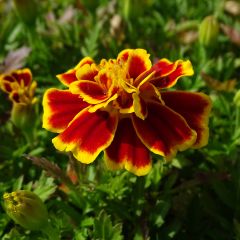
Tagetes patula Queen Yellow Fire
- Flowering time July to November
- Height at maturity 26 cm

Signet Marigold Lemon Gem - Tagetes tenuifolia
- Flowering time August to November
- Height at maturity 23 cm
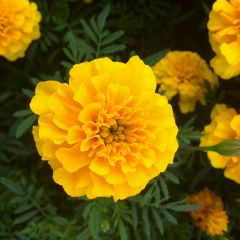
Tagetes patula Durango Yellow
- Flowering time July to October
- Height at maturity 25 cm

French Marigold Mr Majestic Seeds - Tagetes patula
- Flowering time July to November
- Height at maturity 20 cm
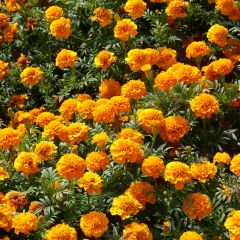
French Marigold Boy O Boy Orange Seeds - Tagetes patula
- Flowering time August to November
- Height at maturity 23 cm

French Marigold Orange Flame Seeds - Tagetes patula
- Flowering time July to November
- Height at maturity 25 cm

African Marigold Crackerjack Mix Seeds - Tagetes erecta
- Flowering time July to November
- Height at maturity 90 cm

Seed Collection of Marigolds
- Flowering time July to October
- Height at maturity 25 cm
Discover other Tagetes seeds
View all →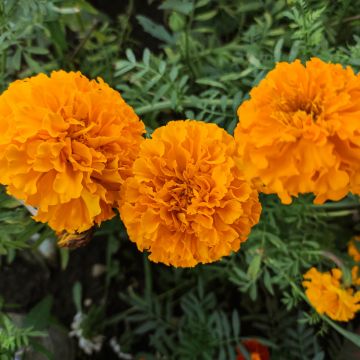
Available in 1 sizes

Available in 1 sizes
Available in 1 sizes
Available in 1 sizes

Available in 1 sizes
Available in 1 sizes
Available in 1 sizes

Available in 1 sizes
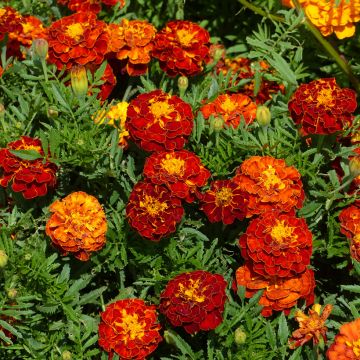
Available in 1 sizes
Planting
Where to plant French marigold or Tagetes?
Originating from South America, French marigold has retained a strong sensitivity to cold. Frost-tender, it does not survive winter in our latitudes. That is why it is grown as an annual in our gardens. However, whether rain, wind or the hottest sun, it will remain vigorous throughout summer.
It needs full sun to flower abundantly, showing tolerance to drought and temporary heat as well as to bad weather and sea spray.
Undemanding, it copes with ordinary, even poor and dry soil, provided it is well drained. However, in fertile soil flowering will be more abundant.
French marigold is a useful plant both in ornamental gardens and vegetable gardens.
Its endless flowering from spring to first frosts makes it ideal for quickly bringing colour to very sunny summer borders, planters, pots, structuring low edges or highlighting rockeries. The lowest cultivars will serve as groundcover during summer or set the foreground of a flowerbed alight.
Feel free to place it in the vegetable garden between ranks of vegetables, at foot of tomatoes or carrots: its roots inhibit spread of nematodes. Its flowers, with such a characteristic scent, repel aphids: plant a few clumps at base of your rose bushes
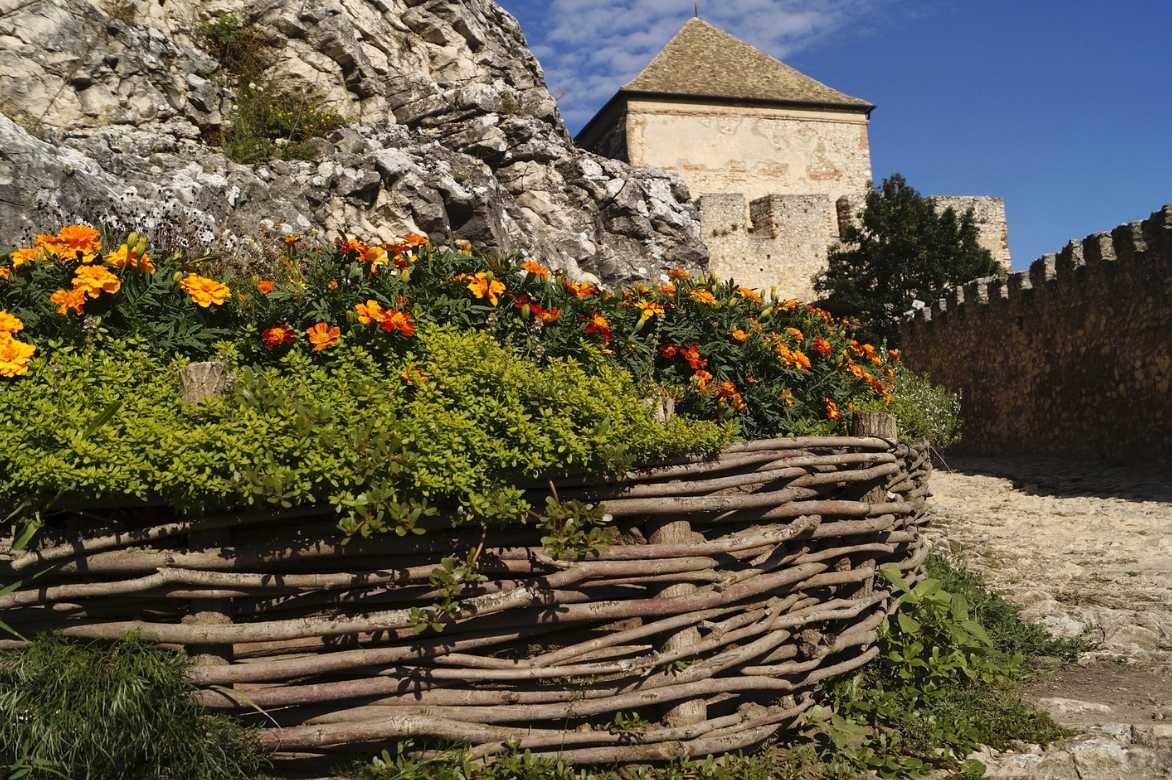
When to plant French marigold or Tagetes?
Plant our French marigolds or Tagetes in plug plants from March to May after last frosts.
How to plant French marigolds or Tagetes?
In open ground
On receipt, pot up and store our young plug plants under cover in a warm, bright place at a temperature above 14°C for a few weeks. In May, after last frosts, you can plant them outdoors.
Plant in tight groups, spacing plants 15 to 20 cm apart at a rate of 5 to 7 buckets per m2. A few Tagetes plants are enough to set a corner of the garden ablaze throughout summer and into autumn, as long as frost does not occur.
- Fork over soil well to loosen it
- Dig a hole three times wider than the plug plant
- Make a good bed of gravel or clay pebbles
- Place plug plant in centre of hole, collar level with soil
- Cover with garden soil mixed with potting compost for flowering plants
- Firm down with foot
- Water
Planting French marigolds in pots or planters
Tagetes are must-haves in summer planters placed in full sun.
- Plant in good potting compost for flowering plants mixed with river sand
- Add some compost
- Water generously at planting
Read also
Succeeding at sowing French marigoldWhen and how to sow marigold seeds?
Once flowers have faded and dried, you can harvest French marigold seeds: sowing is easy. You can also pick from our unique collection of French marigold seeds, some exclusive!
Sowing under cover in March–April
Early sowing of French marigold is easy and produces many young plants.
- In buckets or seed trays, sow the French marigold seeds, covering them lightly with potting compost kept slightly moist
- Keep at 18 to 20°C during germination
- Three to six weeks after sowing, when seedlings have two or three true leaves, separate them and prick out into individual buckets to keep under cold frame
- In May, once risk of frost is definitely past, pot up young plants into planters, pots or plant directly in ground, spacing them 20 to 40 cm apart
- Water well to ensure establishment
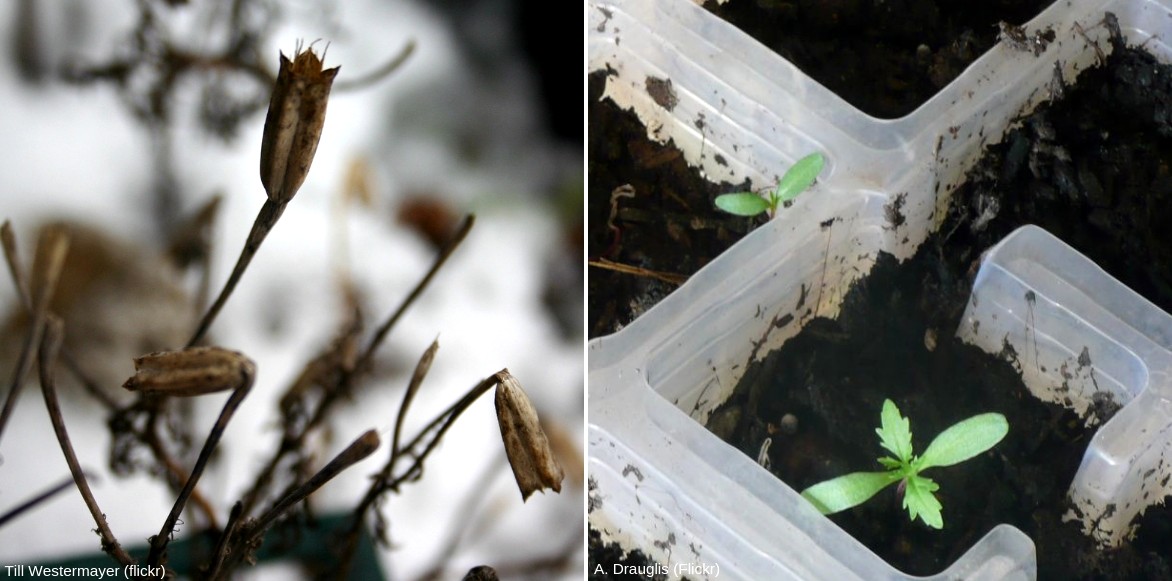
Capsules containing seeds / sowing
Direct sowing outdoors in May
In May, sow thinly by hand or in drills directly in place in well-drained, warmed soil once any risk of frost is gone. About five weeks later, thin out the ranks, leaving roughly 30 cm between each plant.
More tips for successful sowing in our advice sheet.
→ More information in our tutorial: Succeed in sowing French marigold !
Care and maintenance
This short-lived perennial is really undemanding. Pure delight for the warm season and for holiday gardens without gardener! Tagetes tolerates short periods of drought fairly well. Avoid excessive watering, which causes fungal diseases and root rot. It rots in heavy, poorly drained soil.
Water at the base only in case of very hot weather.
In a pot, it should be watered more regularly as soon as surface soil is dry and can be fed with a liquid fertiliser during growth every week.
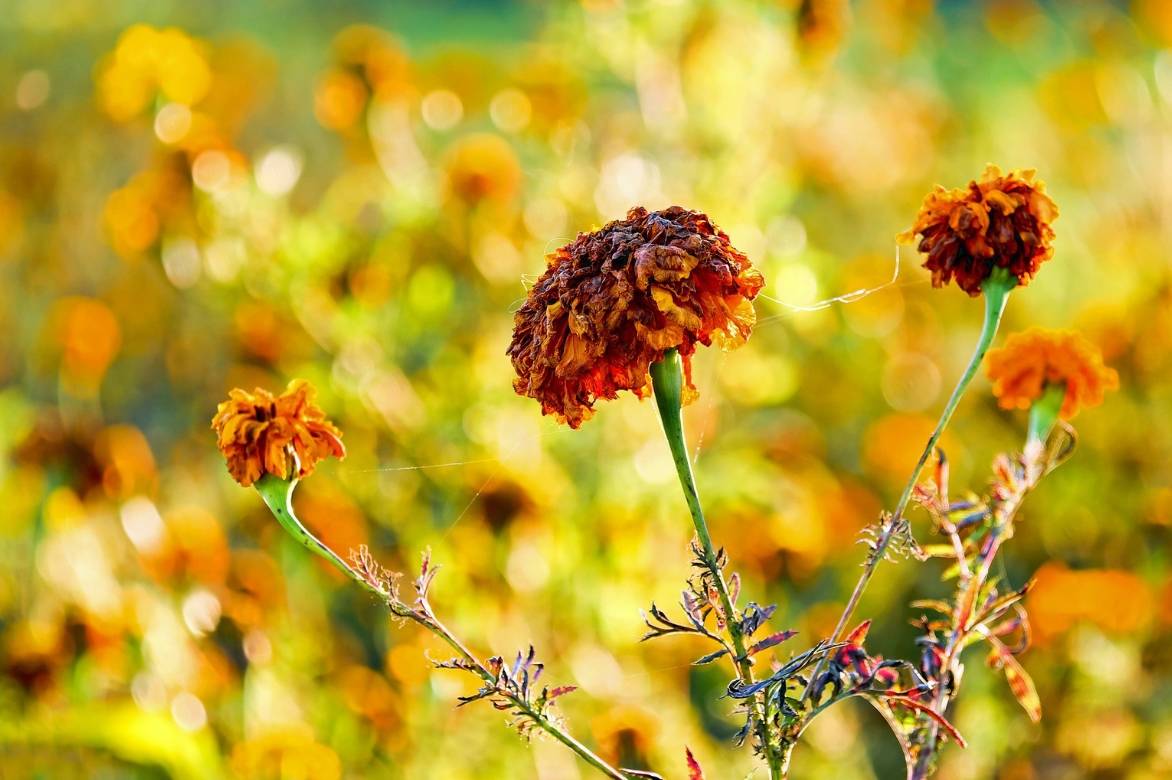
Remove faded flowers regularly
Remove faded flowers regularly to encourage new buds and thus prolong flowering. Pinch tips of stems of young plants when they are about 10 cm tall to obtain a more ramified habit.
In ornamental garden, in autumn, pull up clumps of marigolds. In vegetable garden, after first frosts, you can bury dead stumps in the soil: their roots will retain for some time their repellent properties against nematodes, protecting certain vegetables such as cabbages and carrots.
Potential diseases and pests
French marigold only really has one enemy: slugs and snails, which feed on its young foliage. Discover our 7 ways to fight slugs effectively and naturally and how to make a slug trap.
In poorly drained soil and in cases of excess moisture, it can be susceptible to fungal diseases, which cause root rot.
Propagation
Multiplication of Tagetes is by sowing (see our section on when and how to sow Tagetes seeds, bearing in mind that this annual flower self-seeds easily in the garden but probably not very true to type).
Good companion plants for marigolds
French marigold lights garden ablaze for many months. With its cheerful, good-natured character, Tagetes is indispensable in natural, unpretentious gardens. A few plants are enough to set a border, rockery, small sunny bed or a planter alight in warm, vibrant tones. However use sparingly to avoid clashes: it will brighten every corner with small touches, adding volume all summer with its pompom-like or simple daisy-like look.
Its size allows it to slip everywhere and keep company with many perennials that flower in summer, annuals or even small bushes.
Plant is equally at home in garden and in an organic vegetable garden.
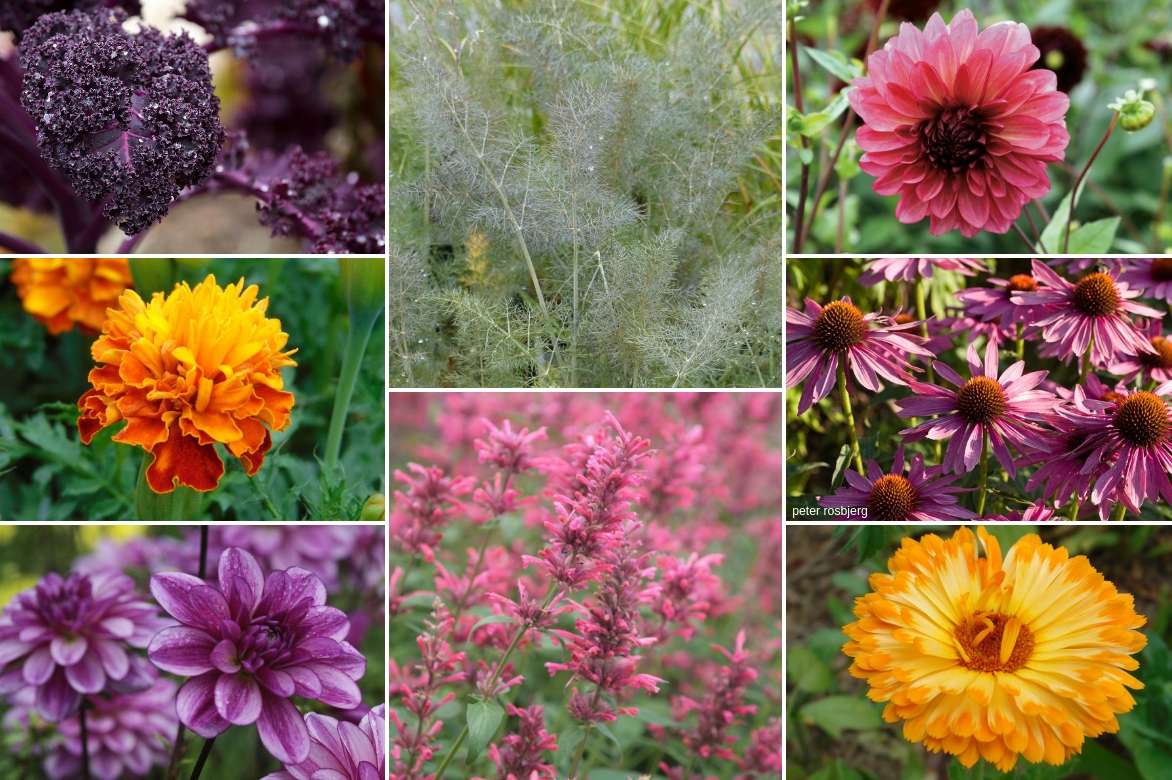
A colourful pairing idea for vegetable patch or border: purple kale, Tagetes patula ‘Mowgli bicolour’, Dahlia ‘Seduction’, Foeniculum ‘Bronze’, Agastache mexicana ‘Red Fortune’, Dahlia ‘Baccardi’, Echinacea purpurea ‘Magnus’, Calendula officinalis… you can add nasturtiums on bamboo tipis, cosmos, zinnias, other dahlias and kale, cardoons and of course other vegetables.
Its flowers combine with orange, vermilion, scarlet and mahogany in the foreground with Cannas, coleus, annual rudbeckias, heleniums, Bidens, Cosmos sulphureus, Gaillardia, Coreopsis, zinnias or daylilies.
A few Tagetes will fit naturally into a Catalan-inspired border in spicy tones surrounded by Echinaceas, California poppies, tritomas or Achilleas.
Tagetes flowers introduce vigorous colour accents into a border; small grasses such as fescues, carex or pennisetums will calm the heat by adding softness.
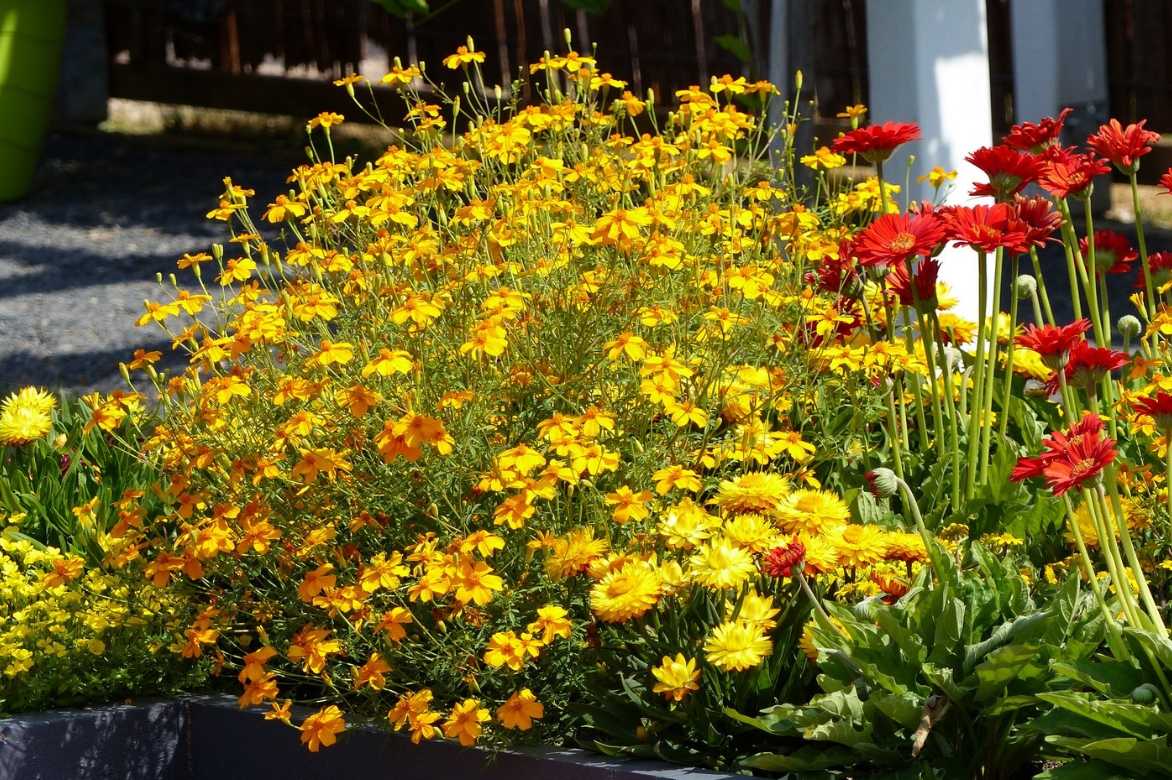
An example of a planter combination with marigolds — why not complete with some grasses?
It is welcome in small touches among the grey foliage of artemisias and Stachys, or among the green-yellow of golden tansies.
Create bold, pure yellow/blue contrasts by placing Tagetes’ sunny flowers next to surfinias, Ageratum, blue salvias. They can be paired with the delicate flowers of perennial flax or Nigella damascena.
In a planter, mix Tagetes with golden or purple alyssums or blue petunias.
In vegetable garden, French marigold traditionally accompanies tomatoes; pair with a few nasturtiums or marigolds, two other edible annuals, or plant at base of dahlias.
Useful resources
- Too much yellow spoils the effect? Discover how to tone down yellow flowers in the garden
- Get inspired by our selection of annual plants on our blog!
- French marigolds are allies of the organic vegetable garden: they naturally keep certain pests away but they are not the only ones, discover our tips!
Frequently asked questions
-
Why are the flowers on my marigolds drying out?
French marigolds don't like to be overwatered: water only when soil is completely dry. They may be suffering from excess moisture that could cause them to rot. Also, this plant needs full sun — is it getting enough? Finally, French marigolds are not hardy and are killed by first frost; in our gardens they do not survive harsh winters.
- Subscribe!
- Contents


































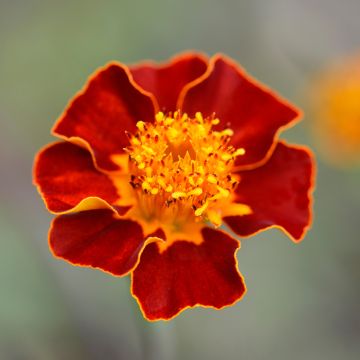
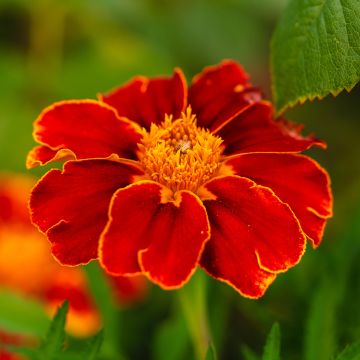
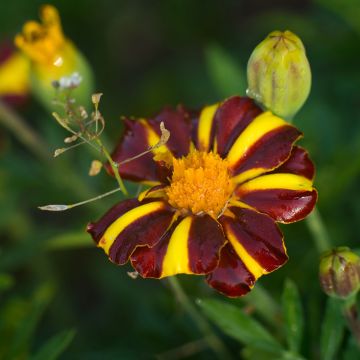
Comments